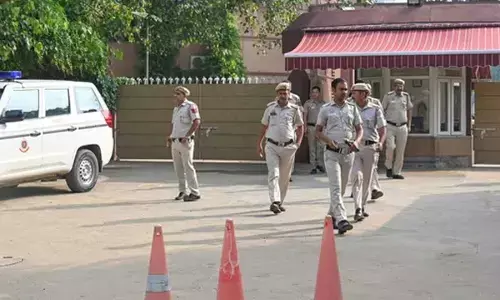The fascinating sight of moving things

Representational Image
The systematic, and apparently endless, motion of the moon around the earth, the earth around the sun, the solar system within the Milky Way galaxy, and the galaxy in the super galaxy and so on have always remained a source of fascination for scientists and amateur sky gazers, as much as the common man, since times immemorial.
The systematic, and apparently endless, motion of the moon around the earth, the earth around the sun, the solar system within the Milky Way galaxy, and the galaxy in the super galaxy and so on have always remained a source of fascination for scientists and amateur sky gazers, as much as the common man, since times immemorial.
The incredibly symmetric, and structured, formations of flocks of birds and schools of fish, while in motion, also present a facet of nature that is immensely appealing. Watching the movements, in the wild, of herds of animals, such as elephants and zebras, is also a very worthwhile experience. Many fascinating and exciting instances chronicling a day in the life of many creatures populating the desert regions of the American South West, were captured in the 1950s amazing movie 'The Living Desert' by Walt Disney.
Another exercise that requires a great degree of synchronisation, coordination, teamwork and precision is that of military forces doing their marches. Of all the different types of marches such as the quick march, the double march, and slow march, I have always been mesmerised by the manner in which the slow march is executed.
The ability to be on the move is probably the most enjoyable sensation for a human being. The most defining moment of a person's life is the time when one learns to walk. First teetering, then stumbling, occasionally falling and later, first with support, and then without, being able to walk on one's own is probably the most satisfying achievement in the beginning of childhood. In later years, one enjoys the early morning walk, especially when there is a nip in the air. And on occasions, when one has the leisure, and the weather is conducive, a jog or a run, in the open, is most satisfying. And when time and opportunity are constraints, the use of the treadmill is an acceptable alternative.
The fun and joy associated with games and sports, such as the running race, the one-legged catch game and the three-legged race, are memories of childhood one really cannot forget. Even after joining the service, I remember how, at Mussoorie, while under training, two of my batch mates and I participated in a three-legged race. The interesting point was that the three of us were of the same height (somewhat short really), and were allotted to the Andhra Pradesh cadre, giving rise to the rumour that allotments to that State were made on the basis of height!
The next stage, in the progression of motion, was learning to ride a bicycle. With great amusement and pleasure, I now recall how one began with one foot on one pedal, balancing the cycle, graduating to pushing one leg through to the other side and using both pedals in what was called 'cross – cycling'. Having mastered that stage, one then swung one's leg over the seat, and started using both legs. The supreme joy of succeeding in the art of balance, and pedaling away on one's own, has few parallels.
In my case, the funny part was that I could reach school (in Guntur, when my father was a lawyer and later a judge, in the High Court), but had to wait till someone came to help me to get off! Different types of races are also organised in cycling, including the slow cycling race, in which the winner is the one who breasts the tape last! One then graduated to a motorised two-wheeler – a scooter first, and then a motorcycle.
I remember the sheer thrill of 'ripping' through (what was then) Lloyds Road at Madras (now Chennai), on a Royal Enfield 'Bullet', with myself on the pillion. The smoothness of the gearshift, and the 'pick up' of the vehicle, were really thoroughly enjoyable. One grew in confidence with time, and soon, my favourite cousin and I, both studying in different colleges in the Osmania University, performed daredevil acts, such as exchanging the pillion and the riding seats on the bike, or the 'no hands' drive. On one occasion I remember (albeit with a bit of a shudder now), jumping from the pillion seat to get on to a passing bus, and, after a few minutes, getting back on to the motorcycle again!
One then graduated to driving a car, with a learner's licence first, and then, a regular permanent licence. Perfecting the art, of the smooth and simultaneous release of the clutch, and engaging the gearshift, was indeed a very satisfying experience. Hyderabad city of the 1960s was home to many vintage cars such as the Rolls-Royce, the Plymouth, the Studebaker, and the earlier models of the Ford, among others. The roads were much less congested at that time, and one could touch fairly high speeds even within the city.
The most convenient, and economical, mode of travel, for most Indians, is the train. I am old enough to remember the days of the steam engine, which laboriously started its journey, huffing and puffing clouds of dark smoke into the sky and reached speeds which we then thought were very high. Then came the improved Canadian steam engines, and then diesel engines, succeeded by electric trains. Speeds, naturally, increased with each improved engine.
The Ahmedabad Delhi bullet train in India today travels at the speed of 320 km ph. While I have many pleasant memories of travelling by train, from childhood to recent times, in many places of the world, the one memory that stands out sharply is the journey, in 1981, from Tokyo to Osaka, by the bullet train in Japan, the view of Mount Fuji Yama, with thick green vegetation and a beautiful small white cap was stunning.
To this day, in spite of a fair amount of understanding of mathematics and physics, I cannot help being fascinated by the sight of trees, electric poles and distant hills rushing past, as the train travels, giving the impression that it is those objects which are actually in motion! And the strange sensation another train passing at the same speed, on a parallel track, giving the impression that both of them are stationary! (The concluding part of the article will appear next week)
(The writer is former Chief Secretary, Government of Andhra Pradesh)
(The opinions expressed in this column are that of the writer.The facts and opinions expressed here do not reflect the views of The Hans India)



















